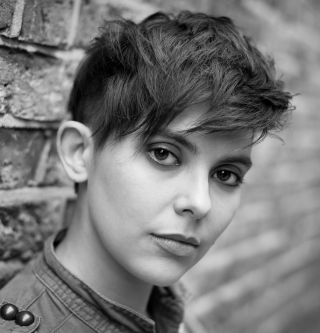
When CN Lester shows up in the waiting room of, say, a doctor’s office and is asked to fill out a personal information form, the inevitable question arises: M or F? The tattooed 30-year-old has developed a habit of inking an extra box and checking it.
“The sheer act of doing so often makes someone take the form back silently,” says Lester, a classically trained musician who lives in London. “You can sometimes feel like a legal nonentity. It’s really frustrating.”
Lester, who as a child hated being called a girl but never felt quite like a “man trapped in a woman’s body,” came out as transgender 15 years ago. As an umbrella term, the word transgender refers to those whose sense of their gender differs from what is expected based on the sexcharacteristics with which they are born.
The transgender stereotype, at least in mainstream culture, is a person who identifies as the “other” gender and switches from a masculine appearance to a feminine one, or vice versa. That narrative has grown increasingly familiar in recent years. And the public visibility of transgender people has taken off: Colleges have created gender-neutral bathrooms and transgender awareness programs; the award-winning Amazon series Transparent centers on protagonist Mort, who comes out as Maura late in life; and transgender actress Laverne Cox has illuminated both the Netflix drama Orange Is the New Black and, last June, a Time magazine cover trumpeting “The Transgender Tipping Point.”
Overlooked by much of the media are those who feel that they are not exclusively men or women—people like Lester who would like their own box to check. They use labels like nonbinary, genderqueer, or one of many related terms that generally describe a sense of gender that’s beyond, or somewhere in between, the concepts of “man” and “woman.”
They may adopt gender-ambiguous names, request the use of a neutral pronoun like zeor they in place of he or she, and cultivate wardrobes and appearances that do not register neatly as male or female. Some take hormones or undergo surgery, modifying attributes from body shape and muscle to sexual and reproductive traits to achieve an internal sense of physical congruence. (These can include procedures known to the trans community as “top” and “bottom” surgery, focused on the chest and reproductive organs, respectively.) They may dispense altogether with features that mark them as masculine or feminine—or choose to embody both.
With the growth of blogs and websites about transgender identities, “people are feeling much more comfortable talking about more than just the two labels,” says Charlotte Tate, a San Francisco State University psychologist who researches social perception and who is herself a transgender woman. “Non-binary and genderqueer folks are using the light that’s been shone onto trans women’s and trans men’s experience to say, ‘Let’s not forget that there is a spectrum of these identities.’”
The Skin They’re In
For the estimated one-tenth to one-half a percent of Americans who identify as transgender, the label they received at birth doesn’t fit. They recall a persistent and long-term sense of discord, often beginning in childhood, between their sense of themselves and their sex characteristics, the gender they’re grouped with in school, and how they are expected to behave. The disconnect, a sign of what psychologists call gender dysphoria, may grow as pubertal changes take hold.
“People with gender dysphoria can’t be talked out of it, usually,” says psychiatrist and psychoanalyst Jack Drescher, who served on a committee on sex and gender identity for the latest edition of the American Psychiatric Association’s diagnostic manual (DSM-5). Most children who exhibit signs of gender dysphoria do not grow up to be transgender adults, he says, but for those in whom the feelings persist, embracing the gender they identify with seems to be the most helpful response.
The origins of gender dysphoria remain poorly understood. Researchers have proposed that hormonal influences in the womb play a role. A 2010 report in Progress in BrainResearch explained that the processes that sexually define the genitals and the brain take place at different times in utero. “In rare cases,” the authors wrote, “these two processes may be incongruent”—in other words, influenced differently by masculinizing hormones, so that a person is born with both a latent feeling of having one gender and the external characteristics typically associated with another.
Using brain-monitoring technologies, researchers have observed some differences, in both the physical makeup of the brain and its activity, between those who exhibit gender dysphoria and those who do not. Such studies represent the most promising empirical approaches to understanding why some people are transgender, according to psychologist Francisco J. Sánchez, an assistant research scientist of human genetics at the UCLA School of Medicine.
Scant research has focused specifically on transgender people who espouse a nonbinary label. A few studies, including a 2008 paper by New School University psychologist Rhonda Factor, have found that about 70 percent of those identifying as nonbinary, or genderqueer, had been labeled female at birth. Factor suggests that those who are brought up as boys may be less likely to openly embrace a self-concept that blurs binary gender categories.
The science of gender is a long way from fully accounting for the variance in the experiences that many people describe. The process by which gender identity comes into being may be “something like a Higgs boson or a black hole,” says Tate. “We have to explain it in all of its complexity.”
Yet nonbinary people point out that neither-nor gender identity is hardly new. Past and present cultures offer various examples of less normative or “third” genders. More than 100 Native American societies are thought to have included a “two-spirit” or flexible gender category. And in South Asia, the traditional community of the hijras has long offered a place for individuals who consider themselves neither men nor women; India recognized an official “third gender” category last spring.
Frankie Reeves, a transgender outreach worker in London who was raised as a boy, had long felt a strong sense of femininity despite not feeling exactly like a woman. At first, Reeves thought it might be a sign of homosexuality but lacked an attraction to men. Discovering information about nonbinary identity on the Internet was a revelation, offering a mode of self-definition and opportunities to meet others: “By the time I was ready to come out and say, ‘I’m trans,’ those options were already available to me.”
Many who arrive at a nonbinary self-concept do so only after considering the more common transgender trajectory—which ends with identifying as either a man or a woman—and rejecting it as ill-fitting. “I didn’t want to fully change to the other gender,” says Micah, a 28-year-old software engineer in San Francisco who blogs on the site Neutrois Nonsense—neutrois meaning “gender-neutral.” Micah was uncomfortable being considered a woman, but living as a man did not seem like the solution. “It took a lot of work and research to discover that there was room for anything other than that.”

THE REAL ME: Micah seeks to cultivate an appearance that is neither masculine nor feminine.
Those who write about their gender dysphoria often invoke metaphors to describe it. Lester has written of feeling like “some kind of alien riding in a foreign vessel,” and of having a deep desire to part with certain typically feminine traits and acquire certain masculine ones: “After half a lifetime as an adult unable to grow facial hair, my hand still expects to feel it.” Lester’s responses have included top surgery and the cultivation of an androgynous appearance. Micah has also undergone surgery and taken testosterone to sculpt a more neutral body.
Describing the feelings underlying these changes “cuts to the fact that this isn’t something that people are making up to be difficult,” Lester says. To those who are unfamiliar with gender dysphoria, the depth of discomfort can be hard to appreciate. “But if you were living in a house which had no central heating, only three walls, and no plumbing, it wouldn’t be too livable in the long term.”
The existence of nonbinary people testifies that there are myriad, complex ways of conceiving of oneself. But it does something else, too, by inviting broader conversations about how everyone understands gender. At a conference on children and transgender issues, Micah recalls, parents didn’t linger on questions about their children’s gender, the ostensible focus of the discussion. Instead, they pondered the gender stereotypes and constraints they encountered in childhood—as girls who shied away from science or sports, or boys who felt they couldn’t express certain emotions.
“Gender is part of your core identity and it goes unquestioned,” Micah says. “As soon as you start questioning, people break down and say, ‘I don’t know what gender is, I just know it’s there.’”
Those who live beyond traditional gender boundaries may encourage people to conceive of their own gender less rigidly, observes Zena Sharman, assistant director of the Institute of Gender and Health at the Canadian Institutes of Health Research. “Rather than leaning heavily on taken-for-granted categories, there’s an opportunity to think about and unpack the containers we call “man” or “woman,” or “he” or “she.”
For many, such meditation will not lead to a life-changing transformation or a new name. But it may offer a more nuanced understanding of who we are.
Roads Less Traveled
People who identify as nonbinary are increasingly recognized within the larger transgender world. On blogs and websites like Genderqueer Identities and Life Outside The Binary, they chronicle their intellectual and physical journeys, tackle semantic questions, and connect with others who are transcending gender norms. In a national survey on transgender discrimination in 2008, about a third of respondents said they were not exclusively a man or woman (some said they were both; some said neither). Signs of acknowledgement have emerged in the realm of social media as well. Facebook last year added more than 50 gender label options besides male and female, including nonbinary, agender and bigender. The dating site OkCupid followed suit in the fall, offering 20 new terms pertaining to gender.
Cisgender: Identifying with the gender that is typically associated with one’s designated sex; not transgender.
Bigender: A dual-gender identity, with two sides experienced and expressed either simultaneously or at different times.
Androgynous/Androgyne: Having both traditionally masculine and feminine characteristics and/or identifying as between male and female.
Written By: Matt Huston

No comments:
Post a Comment